Varieties
Various mustard recipes will call for either:
- White (Sinapis alba)
- Brown (Brassica juncea)
- Black (Brassica nigra)
These are each different varieties in the mustard family. Sinapis alba is the variety most commercially grown for its seed. However, any variety of mustard will produce a flavorful seed capable of making a delicious spread.
Choose a variety that you like both as a green and a seed. You will be able to harvest greens from your mustard plant before it flowers and produces seed.
Planting
Prepare a planting area by working the soil and removing weeds or mulch. Amend poor soils by topping the area with 1-3 inches of finished compost and working it in with a garden fork.
Mustard seed can be directly sown into the ground 3 weeks before the last frost in your region. Spring crops do well because the warming weather will trigger the plant to flower. Fall plantings in milder regions are also possible.
Plants prefer full to partial sun, well-draining but constantly moist soil, and plenty of rich compost. While mustards grown for greens do not require thinning, mustards grown for seed should be thinned as the plants will get much larger before finishing. Plant them at 1-inch intervals and thin seed mustards to 6 inches after they sprout.
Plant Care
Keep the plants well watered and weeded to ensure maximum productivity. Moist soil will give the plants some resistance to bolt when the weather gets warm. If temperatures rise above 80°F (26.6°C) cover mustard plants with a shade cloth to keep them from bolting. Bolting is when the plant suddenly jumps into a flowering and seeding mode before finishing it’s vegetative life cycle.
If you’re growing mustard for seed it can seem tempting to encourage bolt in order to harvest earlier. The seeds produced will be less flavorful and far smaller than seeds from plants that complete their full lifecycle.
Harvest
Mustard seed pods will appear in summer after the plant blooms. Wait until the pods have started to brown before harvesting them so that all the seeds get a chance to mature. Don’t wait too long, though, because pods will eventually open and drop their seeds. Place the pods in a paper bag to let them fully mature and dry.
After a few days to a week in the bag, the pods will open on their own. Shake the bag to free all of the seeds and them dump it into a bowl and pull out the pod shells.
